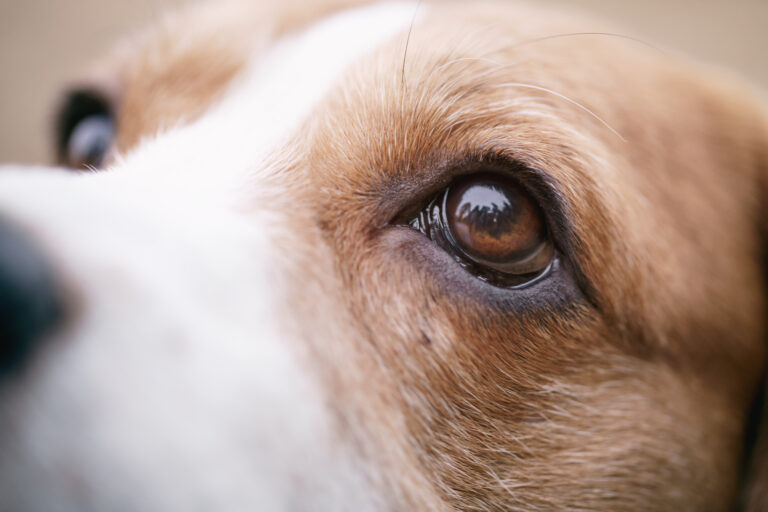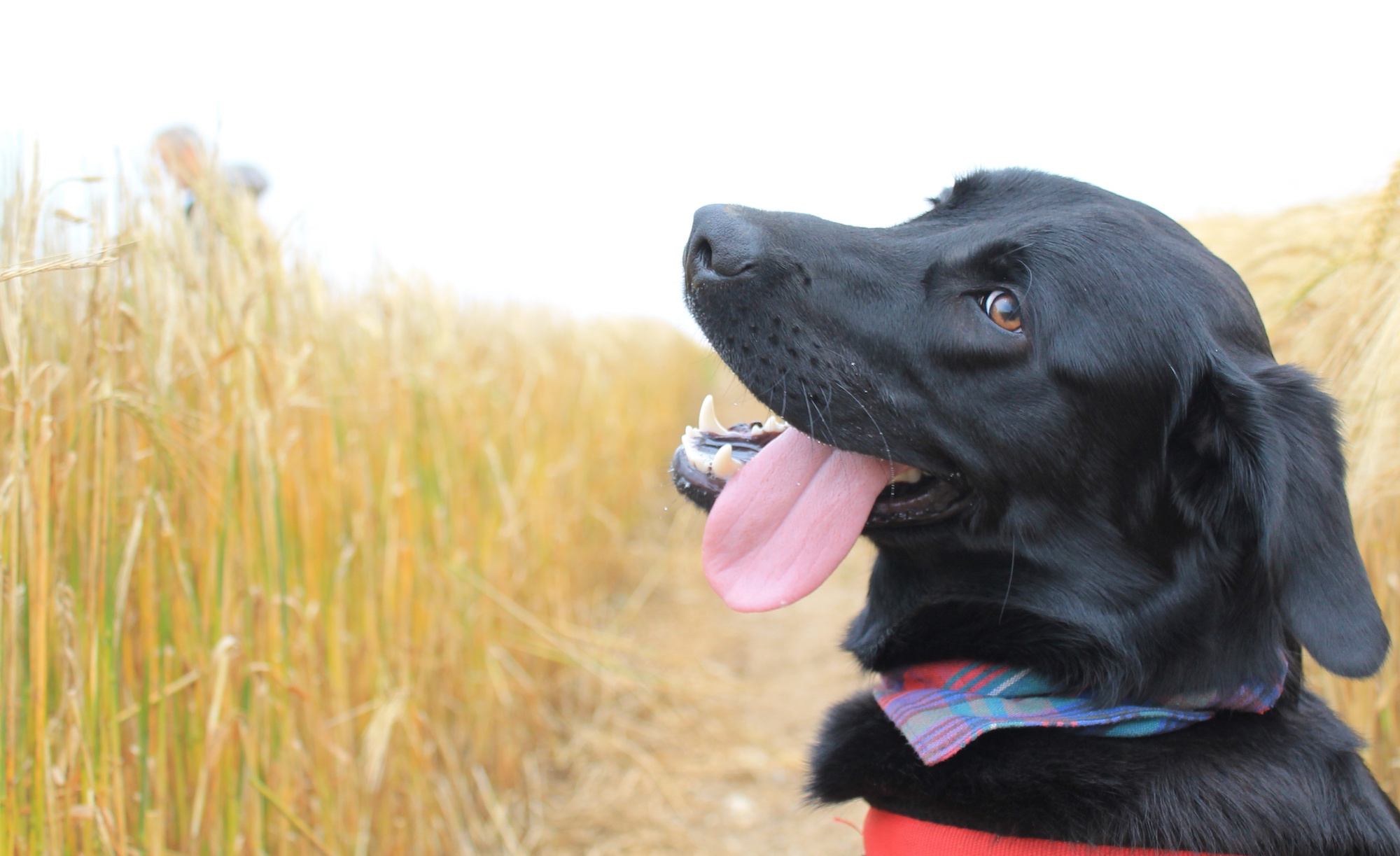You may have heard it before: dogs have mediocre vision, and what they do see is only in black-and-white. Sight, the popular belief goes, is not a dog’s sensory strong suit—their superpowers lie in smell and hearing. But that’s a myopic way to view dogs’ eyes.
If you’ve ever been swindled out of a portion of dinner by a dog’s pleading look, or had your pup watch your every move while you putter around the house, you’ve seen firsthand that our canine companions use their eyes for so much more than seeing.
While dogs don’t have the same visual acuity other hawk-eyed creatures (like hawks) do, their eyes are not only important—they’re evolutionary marvels. Whether spotting something in the periphery, giving the whale eye in an uncertain situation, gazing lovingly and blasting oxytocin at their human, or using their best pleading puppy dog eyes to score treats, dogs’ eyes are an oft-overlooked wonder that have helped these animals become the loving companions and hard workers we know today.
Here’s a long look at everything you need to know about your dog’s eyes.
What eye colors can a dog have?
Most dogs’ eyes are various shades of brown. But dogs can have just about any other eye color, too. You’ve not doubt seen huskies with blue eyes, or even one blue and one brown eye (a condition called heterochromia). Though rarer, dogs can also have green or hazel eyes. Like humans, puppies’ eyes may change color as they get older.
How alike are human and canine eyes?
Unlike the sometimes dramatic variations between humans’ and other animals’ eyes, a dog’s eyes look eerily similar to ours, from the pupil shape and iris colors, to the seeming ability to convey emotion with the simple lift of a brow—and there’s a reason for that.
Structurally speaking, human and canine eyes are very similar. Our eyes function much like a camera—taking light and converting it into comprehensible images. We both have round black pupils that take in light, surrounded by pigmented irises that regulate the amount of light entering the eye (this is why your pupils dilate depending on how bright or dark it is). The pupil and iris then send that light through the lens to the retina, the tissue lining the eye, which processes and turns that light into an image that the brain then interprets.
But there are several significant differences between how we and our dogs see the world, all of which tell us about who dogs were before they joined us around the fire several thousand years ago and who they have become as we have evolved together.

Dog eye anatomy
Dogs don’t have a mere two eyelids—they have three. While your dog may blink with two eyelids, just like we do, they also have a third lid, called a nictitating membrane or a haw, which moves horizontally across the eye from the inside corner.
The haw evolved to serve three purposes: protecting the eye from dust and other physical contaminants that can scratch the cornea, keeping the eye moist, and contributing to immune function—all while allowing your dog to see. This is especially important as dogs are low enough to the ground that walking through grass and other vegetation poses more of a threat to their eye health than it would to us.
Where is this third eyelid hiding? you might be wondering.
Dog owners who live with hounds, spaniels, and other droopy eyed pups are likely familiar with the fact that dogs have haws, as the membrane is relatively prominent in these breeds, but in most dogs you can only see a very small portion of it at the inner corner of the eye. Occasionally you can see the membrane start to pull across the eye as a dog falls asleep or is sedated.
How well can dogs see?
While dogs can outsmell and outhear humans without a contest, we have dogs beat when it comes to visual acuity. At their peak, humans typically have what’s known as 20/20 vision—the ability to clearly see objects of a certain size while standing 20 feet away. Though visual acuity can be breed dependent, many dogs, experts believe, have 20/75 vision, which essentially means that they have to be 20 feet from an object to see it with the same accuracy as a human can from 75 feet.
Are dogs nearsighted or farsighted?
Generally, dogs are neither nearsighted (meaning they can see nearby objects clearly, but struggle to see objects farther away) nor farsighted. Some research indicates, however, that certain breeds—like Rottweilers, German shepherds, and miniature Schnauzers—are more prone to being nearsighted. And one study found that dogs may become more nearsighted as they age.
Do dogs see in black and white?
Contrary to popular belief, dogs do not see in black and white. They can perceive color—just not as many colors as humans can. So while they’re not walking around in a confusing landscape of varying shades of gray, life isn’t exactly a riot of color either.
Dogs have fewer cone cells (photoreceptors that allow mammals to perceive colors) than humans. Where we have three types of cones, dogs only have two, meaning they see only yellow and blue, and their vision is comparable to humans with red-green color blindness. The world is full of dull browns, greys, yellows, and blues, making it harder to distinguish that bright red toy from your hardwood floors.
To make up for a lack of color, dogs use smell, texture, and other sensory cues to perceive their surroundings accurately. You’ve probably heard that dogs “see” with their noses, which is an indicator of just how much information they process through their olfactory system.
That said, dog vision is actually better than human vision in several key ways.
Night vision
Humans are decidedly diurnal creatures. We function during the daytime, eating, working, and moving around in the light. Dogs, on the other hand, evolved from wolves, who hunt and move largely at dawn and dusk and during the night, requiring the ability to see in low- or no-light conditions, and their eyes reflect that heritage.
Dogs not only have more rods (the photoreceptors that allow mammals to see in the dark), but they also evolved a reflective layer behind the retina, called the tapetum lucidum, which acts like a mirror, thereby increasing light sensitivity at night. (This layer is also the reason dogs’ eyes shine at night or in photographs.)
Field of vision
Dogs also have wider fields of vision than humans, thanks to the fact that their eyes sit relatively wide on their skulls compared to ours. Depending on the breed, a dog’s field of vision is anywhere between 240 and 270 degrees (compared to our 180-degree field of vision). That means they can see more of their surroundings without moving their heads, making hunting and watching for danger easier.
But with a better field of vision comes compromised depth perception, which helps with jumping and catching—hence why so many dogs have trouble catching treats or toys tossed at close range.
It’s perhaps odd to think about all of these differences combined: a wide, somewhat blurry, dull field of vision doesn’t exactly seem like the best evolutionary path for these essential organs. But that doesn’t tell the whole story.
How dogs use their eyes to communicate
One of the great injustices of life is that we can’t just talk with our dogs. But by using a combination of body language, verbal communication (barking, for example), and eye contact, dogs can effectively communicate with their two-legged companions.
Puppy-dog eyes: expressing emotions with a look
Over the course of their 30,000-odd years by our sides, dogs have evolved more expressive facial features than their wild cousins, giving them the uncanny ability to convey complex emotions with the mere lift of a brow.
Recent research has found that dogs possess a set of muscles surrounding their eyes that allow them to project sadness, uncertainty, defiance, and other “human” emotions, while wolves do not. One muscle—the levator anguli oculi medialis (LAOM)—lifts the inner eyebrow, enlarging the appearance of the eye and making dogs seem almost baby-like, while another muscle—the retractor anguli oculi lateralis (RAOL)—pulls the eyelid towards the ear, further enhancing the enlarged appearance. All dogs have LAOM muscles, and all dogs except Siberian huskies have the RAOL muscle (making their puppy dog eyes ever so slightly less prominent).

Researchers believe that dogs evolved these muscles specifically to communicate with and, well, manipulate their human companions, effectively “weaponizing” their cuteness. In a sense, this is your dog’s way of saying “please” or conveying a want or need.
If you’ve ever been a victim of puppy-dog eyes, you know how effective they are at achieving a dog’s goals, whether a bite of your food, a softer countenance when they’ve done something wrong, or a nice, long walk outside.
Dog eye contact: bonding or threat?
For dogs, staring has the power to convey threats, defer to other dogs or people, and even bond with their human family members. Their intention depends on the context—who is doing the staring, along with body language, and the overall atmosphere.
Take eye contact between a canine and their owner. A 2015 study showed that eye contact between dogs and their owners increases oxytocin levels, increasing bonding and feelings of love. Researchers even compared it to parent-infant bonding.
Eye contact isn’t always positive, however. Staring (and stiffening) is relatively high on the canine ladder of aggression and can be a sign of stress or anxiety. Further, depending on how your dog was socialized, any kind of prolonged eye contact can be seen as a sign of dominance or a threat.
Finally, if you ever catch your dog giving the side eye—also known as the whale eye—that’s another sign of discomfort, funny as it may look, so take it as a sign to help them find comfort or get out of whatever situation they’re currently in. Learn more about what a dog’s stares mean here.
How can I tell if my dog’s eyes are healthy?
The color, shape, and even moisture content of your pup’s eyes can alert you to underlying ailments.
As with humans, a quick glance at your dog’s eyes can tell you a lot. Are they clear or cloudy? Are the whites of the eyes actually white, or are they red? Do they shine with moisture? Is there any discharge or discoloration? Is your dog pawing at their eyes? They could all be signs of eye problems common in canines.
Common dog eye problems
Cataracts: Cataracts are a medical condition wherein the eye lens becomes progressively opaque. Cataracts can cause impaired vision and even blind spots, and they’re easily identifiable as thick, white spots at the center of the eye. Cataracts are different from the general clouding of the eye as dogs get older, which generally has a blue tint. If they’re severe enough, a vet might recommend surgery to remove the tissue and restore your dog’s eyesight. Cataracts are often inherited, but can also be caused by eye trauma or other underlying eye conditions. Cataracts are also linked to diabetes. This is one of the many reasons to keep your dog at a healthy weight and lean body condition.
Cherry eye: The nictitating membrane or haw is attached to the rest of the eye by muscle fibers that are weaker in certain dog breeds. When those muscle fibers fail, the tear-producing gland that is part of the haw can prolapse, and become visible at the inner corner of the eye. It can be fixed with surgery. There are also eye drops that can be used to make your dog more comfortable in the meantime; your veterinarian will be able to explain if this is a reasonable option.
Conjunctivitis: More commonly known as pink eye, conjunctivitis is inflammation or infection of the conjunctiva, the tissue that lines the eyelids (including the third eyelid) and loops back over the eye to protect the sclera (the white part of the eye).
Corneal scratch or ulcer: Just as with humans, dogs can scratch their cornea, the clear outer layer of the eye, which can cause mild pain and tearing or even milky, pus-like discharge. If not treated, ulcers can lead to permanent damage and infection, loss of vision, or even necessary removal of the affected eye. Most ulcers are treated with medication prescribed by a vet.
Dry eye: Most often indicated by redness, excessive blinking, and even yellowish mucosal discharge, dry eyes are not just uncomfortable for your pup. If your dog isn’t producing enough tears, that can lead to larger problems such as recurrent corneal ulcers and permanent vision loss. Dry eye is generally treated with lifelong application of lubricating eye ointment.
Glaucoma: Watery discharge, redness, protruding or enlarged eyes, and even lethargy are all signs of glaucoma, which is an unhealthy increase of pressure in the eye. Glaucoma can damage and potentially destroy the retina, causing pain and even blindness. Glaucoma can be genetic or caused by secondary factors, such as tumors behind the eyes or scar tissue build-up from frequent infections. To prevent glaucoma from progressing and doing severe damage, a vet will prescribe medication that promotes fluid drainage and decreases eye pressure. In advanced or acute cases, or in the case of severe pain, the affected eye may need to be removed in order to make your dog more comfortable.
Tear stains: Tear stains are brown or reddish marks appearing under your dog’s eyes. They’re especially noticeable on dogs with white coats. These marks are caused by compounds called porphyrins, excreted through a dog’s body via tears, saliva, and urine—they show up when a dog produces excess tears, or can’t drain their tears efficiently via normal means. There are a number of causes of tear stains, including genetics, allergies, eye irritation and infection, and poor diet (many customers of The Farmer’s Dog report that their dog’s tear stains disappear after switching to fresh food).

How can I take care of my dog’s eyes?
The most important steps to take in caring for your dog’s wonderful peepers are close monitoring for any abnormalities, and regular vet care. While some eye problems are more obvious than others to dog owners, there are plenty of red flags that a vet can spot before they become a serious issue.
Here are some tips for monitoring your dog’s eye health at home:
- Check the whites and make sure they’re not red, which can indicate dry eyes, corneal scratching, and more.
- Take your dog into a well-lit area and examine their pupils. Are they clear or cloudy? If they’re cloudy, that could be a sign of cataracts (and vision loss).
- Monitor your pet for excessive squinting, blinking or pawing at the eyes.
- If you notice anything about your dog’s eyes that looks abnormal, make an appointment with your veterinarian in order to determine if the eyes need to be treated and how.
And don’t forget to take every opportunity to gaze into your dog’s wondrous, expressive eyes—it’ll make you both feel really, really good.




